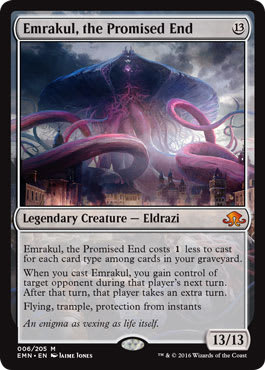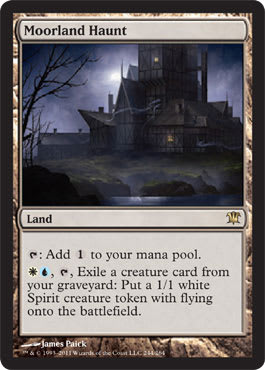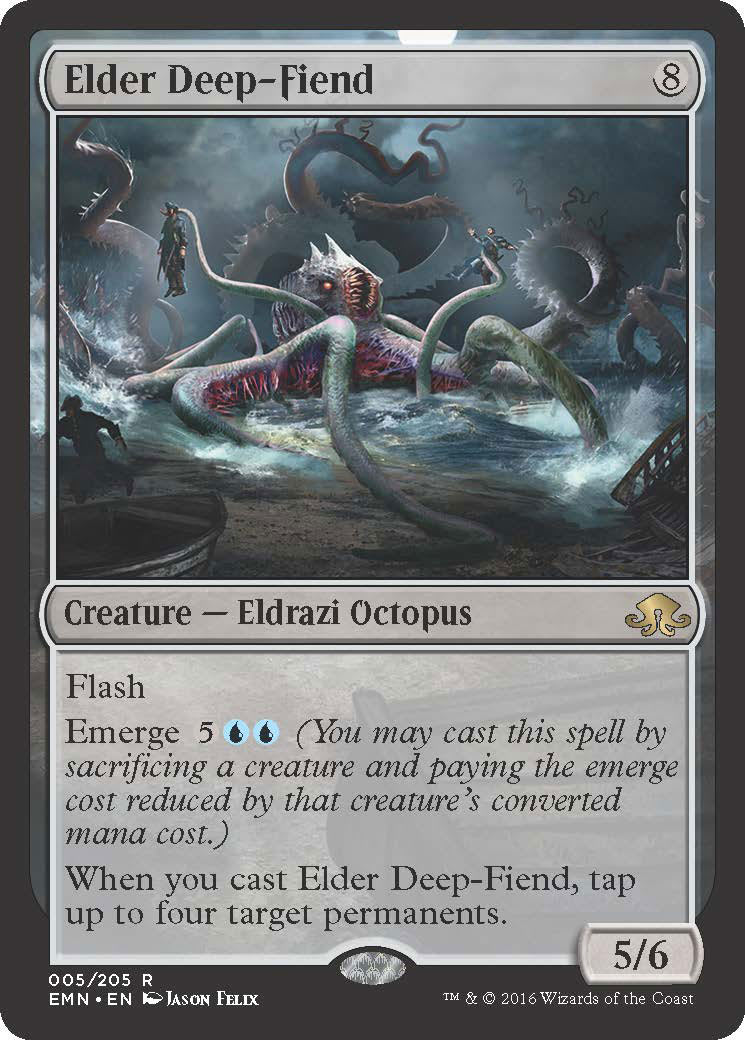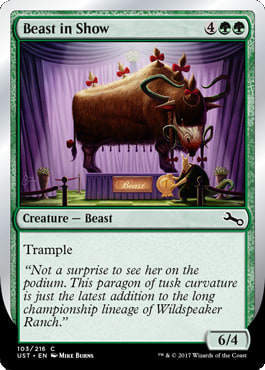Emrakul, the Promised End was a totally well designed card!
Boom, that's how you start an article, baby! Hit 'em with the obviously absurd claim right out of the gate so they'll be forced to read the rest of the piece before going to the comments section to offer well-reasoned counterpoints! That's definitely how the Internet works!
Ok, ok, I'll confess to some exaggeration here. The Promised End is only well designed from a particular perspective, one that probably doesn't trump perspectives grounded in the question of whether or not people actually want to play Magic. But let's see what happens when I lead off with a more specific claim:
Emrakul, the Promised End's design fits well into Magic's New Weird traditions!
This isn't exactly a claim to launch a thousand flamewars. I'm not sure most people know what the New Weird is, let alone have strong feelings about Magic's place within it. As much as I constantly pretend otherwise, criticism does ultimately live or die based on people's emotional investment in either the claim being argued or the object of study. At the very least, a claim should probably have some practical application.
Thankfully, Magic, as a constantly developing game, always offers tons of sites for practical application, and places where I can lever out space for weird lit crit questions like "just what the heck is Magic's genre?" After all, if The Promised End is a well designed card, that has some major implications for design moving forward!
Let me get my spawns in a row here, though, and explain the odd, complicated placement of Magic within the New Weird genre. I've already talked about this before, with respect to Ixalan's ship city High and Dry and the way fantasy games and fantasy stories use "The Tavern" as a convenient trope. In that article, though, I sort of brushed aside the question of just what the New Weird is, or at least my explanation was a little garbled.
Unfortunately, this is because the New Weird is kind of nebulous. This is probably somewhat fitting for a literary tradition that draws so heavily on weird horror: it's an indescribable genre for indescribable cosmic subject matter. Let's take a first stab using this bit from Jeff VanderMeer's definition though:
As part of [an urban, complex, realistic] awareness of the modern world, New Weird relies, for its visionary power, on a “surrender to the weird” that isn’t, for example, hermetically sealed in a haunted house on the moors or in a cave in Antarctica. The “surrender” (or “belief”) of the writer can take many forms, some of them even involving the use of postmodern techniques that do not undermine the surface reality of the text.
This is kind of an odd definition, merging together a focus on contemporary realism with this "surrender to the weird" that permeates the whole of a story or world rather than just "a haunted house" or "a cave in Antarctica". That second reference is handy because it's a nod to HP Lovecraft's "At the Mountains of Madness," a story where the weird, alien horrors are locked in just such a cave. So the New Weird of the 90s is part of a broader tradition of weird SFF and horror, sharing space with Lovecraft, but the weirdness isn't somewhere else, it's spread through the world. A world that is still, nevertheless, realistic. Oh, and, in form, this setting can be rendered in postmodern or avant garde ways: less Hero's Journeys, more Fear and Loathings. Hold on to that point for a moment.
This description actually fits Magic pretty well, I think. I just recently wrote a whole thing on my first Magic deck and how it introduced me to the game's alien ecologies, after all. I'm not sure how much we can rely on the definition to stay solid if we poke at it — like, how much can we prod at the claim that New Weird is "urban" before we start getting examples that cause strong borders around the concept to dissolve? — but a casual trek through Magic's history gives us plenty of New Weird examples.
The very conceit of Mercadia feels on point, for example. The world is ruled by a city of incomprehensible geography perched atop an inverted mountain, where the strings are actually pulled by a bunch of fancy goblins? Yeah that's pretty weird. But more than just being weird in the lower case sense, it's also a great example of a setting where the literal mechanics of the world blend with the literary. Mercadia City can both be treated seriously within the setting as a literal state of the world, something that doesn't "undermine the surface reality of the text," but it can also be seen as a kind of satirical commentary on . . . well, we can finish that sentence a bunch of ways, probably, perhaps most provocatively with "Capitalism."
And, of course, Magic has plenty of tentacles, the ultimate sign of the Weird. Tentacles are a great symbol precisely because they're so deeply alien yet so clearly physical. They seem almost to be of unfamiliar matter, matter that taunts by our inability to come to grips with what we see. Emrakul might maintain her rough morphology between depictions, but it is fitting that none of her art can quite manage to agree on the specifics. We might imagine this the visual equivalent of what China Mieville describes as "a visionary rumination on the horror of octopus-ness," it's author, Victor Hugo, describing his subject "in a vomit of aghast and contradictory metaphors and similes."
This poses kind of a problem for Magic, though. Many of the sources for the New Weird have this awesome or awe-ful quality to them, where no matter how material the matter of the world might be, it still has a kind of post-rational quality to it, a sliding, oozing quality that defies rational categorization.
Magic: The Gathering has a comprehensive rulebook that runs 222 pages. Single spaced. At a small font size.
Do you see the issue here?
Actually, any association between fantasy games and the New Weird, or any Weird at all, is a bit odd. After all, the Weird is characterized precisely by stuff that challenges systemization. It's touchstones, settings like Gormenghast and Viriconium, are deliberately uneasy about world-building, rules, and canonicity. The tentacle is a fitting symbol of something that writhes its way into master narratives and pulls them apart.
So it feels a little weird to stick a stat block on it.
Fantasy games are all about systemization. It's hard to imagine a greater master narrative than a system that defines every rules interaction possible within a narrative! But the tentacle, and the New Weird genre, tends to be postmodern. Moreover, it tends to just not fit that well into rule systems. Mieville himself points out that trying to provide a stat breakdown for something like his Avanc, the massive extradimensional sea creature that for a time is yoked to the entire metropolis of Armada, would be very silly. What would it even mean to give something of that size stats?
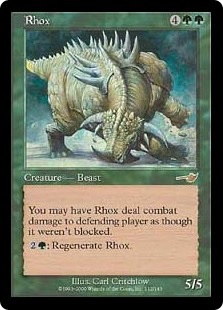 From this perspective I think it'd be easy to claim that Magic might have New Weird resonances, but it can never, itself, fit comfortably into the genre. I think also that it'd be relatively easy to argue from various case studies that Magic has gotten less weird over time. Old venerable Rhox is sort of my go to example, at least mentally, for this shift. Poor Rhox went from some weird Green lizard troll rhino thing to just being a rhino furry, and moreover just one of a whole species of rhino furries, who now have the rhino creature type (though not the "furry" creature type, yet). Bit of a letdown given how cool and odd the original design is!
From this perspective I think it'd be easy to claim that Magic might have New Weird resonances, but it can never, itself, fit comfortably into the genre. I think also that it'd be relatively easy to argue from various case studies that Magic has gotten less weird over time. Old venerable Rhox is sort of my go to example, at least mentally, for this shift. Poor Rhox went from some weird Green lizard troll rhino thing to just being a rhino furry, and moreover just one of a whole species of rhino furries, who now have the rhino creature type (though not the "furry" creature type, yet). Bit of a letdown given how cool and odd the original design is!
And yet . . .
The timeline doesn't quite matchup. The transition from "summon" to "creature" and the streamlining of the rules into something more rigorous happened well inside Magic's first decade. Rock Hydra's "During upkeep, new heads may be grown for ![]()
![]()
![]() apiece" seemed pretty bizarre and rough even as far back as 2000 or so, for example. In other words, a bunch of the systemization stuff happened before some of Magic's weirdest content, or at least contemporaneous with it. The serious strangeness of Phyrexia, Rath, Mirrodin, Mercadia, and post-Invasion Dominaria arrived on the scene despite this need to systematize. And the presence of historically/politically/psychologically grounded narratives and perspectives like those of Xantcha and Yahenni exists alongside their intriguing, exhilarating alienness, accessible only through a surrender to the weird.
apiece" seemed pretty bizarre and rough even as far back as 2000 or so, for example. In other words, a bunch of the systemization stuff happened before some of Magic's weirdest content, or at least contemporaneous with it. The serious strangeness of Phyrexia, Rath, Mirrodin, Mercadia, and post-Invasion Dominaria arrived on the scene despite this need to systematize. And the presence of historically/politically/psychologically grounded narratives and perspectives like those of Xantcha and Yahenni exists alongside their intriguing, exhilarating alienness, accessible only through a surrender to the weird.
This might be a testament to how the weird seeps in through the cracks of a game's systems, in proper postmodern fashion. The standards of creature typing, most notably of all, have to constantly deal with the long shadow of Jorge Luis Borges and the whole postmodern challenge to taxonomy. Sure, the Great Creature Type Update may have flattened out some of the weirder diversity to Magic's fauna, but there's plenty of things conspicuously given placeholder creature types. How many horrors, beasts, and illusions are categorized that way because someone took a look at a mass of tentacles and threw their hands up in "surrender to the weird"?
The compromises made between narrative and gameplay actually enhance the weird effect. The very need to have "beast" as a lump category for tribal deck-building reasons — a surrender to systemization — means that the creature type is a strange menagerie of often wildly different monsters. While I'd love to see some of these get their own type (surely it's time that Baloth and Thoctar were given secondary types alongside "beast," particularly in light of Beast In Show!) there's something kind of cool about the fact that Magic inevitably ends up encountering monsters that, for lack of better terms, simply become beasts, or illusions, or horrors, or elementals.
And so, it makes some sense that at some point Magic's need to stick stat blocks onto Cthulhu would result in an unexpected horror getting unleashed on Standard.
There's something unsettlingly fitting about the fact that most of the true weird horrors of Magic are known only by their touch: Urborg itself is Yawgmoth's tomb but where is the body? Marit Lage's strange powers and avatars emerge from ancient glaciers but Lage herself is nowhere to be seen. The one time we get to see one of these horrors manifest directly, She has to be quickly removed from the game itself! Oh, to be sure, Emrakul, the Promised End was pushed in development in an effort to make her more over the top than Her previous incarnations in a way that would be viable in various formats . . . but isn't that telling? Wizards of the Coast sought after cosmic madness and boy, did they ever find it!
I'm not necessarily claiming that creating a card that warped Standard in a way that was apparently pretty miserable to play was a good call from a game design perspective . . . or not exactly, anyway. It's just that if we take seriously the idea that Magic is a part of a particular literary tradition it makes some sense to look at how the mechanics fit into that tradition. And I can't deny that there's something really pleasing to me about the way The Promised End's journey through Standard mirrors the impact she had on the story, and how she eventually had to be dealt with — not by anything so trivial as destruction but through a kind of binding that prevented her from manifesting (at least for now).
The biggest argument against her design and banning is probably the money lost when people speculated on the card only to see it drop in value after it was removed from legal play. But well, frankly, if suddenly losing $80 to the vagueries of a game played with pieces of cardboard makes you uncomfortable, can I suggest that blaming the design of individual cards is a rather silly way of tackling the problem?
If nothing else, I think Emrakul demonstrates that Magic's systemization doesn't bar it from being part of the New Weird, or at least a part of the longer weird fantasy tradition, not just in terms of its stories but in terms of its setting design and the story that the cards themselves tell, mechanically. This is less an outright argument that Emrakul, the Promised End is good than a push to consider that a tournament-and-finance-centric perspective on Magic (or hell even a fun-centric perspective) is not the only perspective there is. If we're going to treat Magic as having artistic merit — if we're going to have "Magic art shows" and discussions about the stories as literary texts — I think we have to at least be open to radical reappraisals along these lines, no matter how weird they are.
















